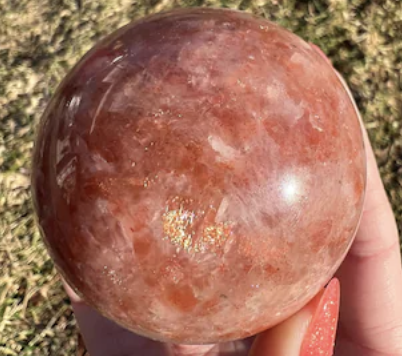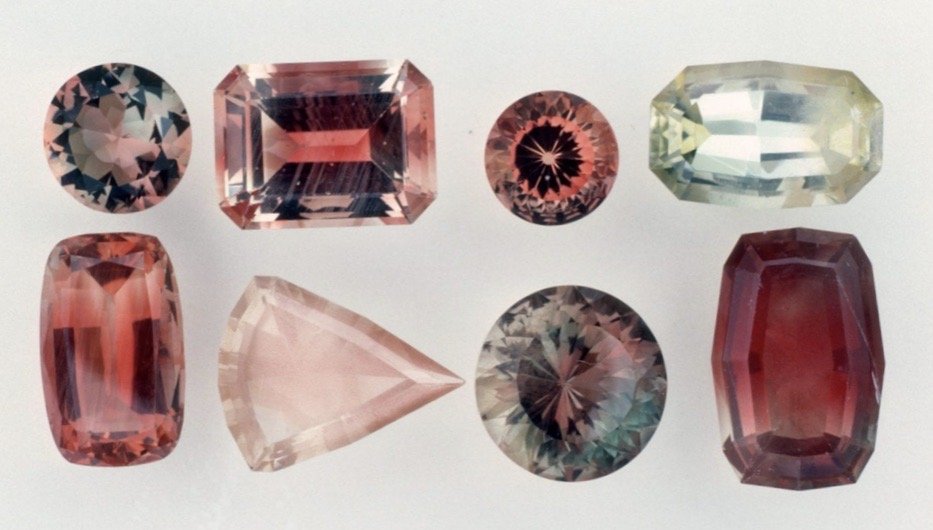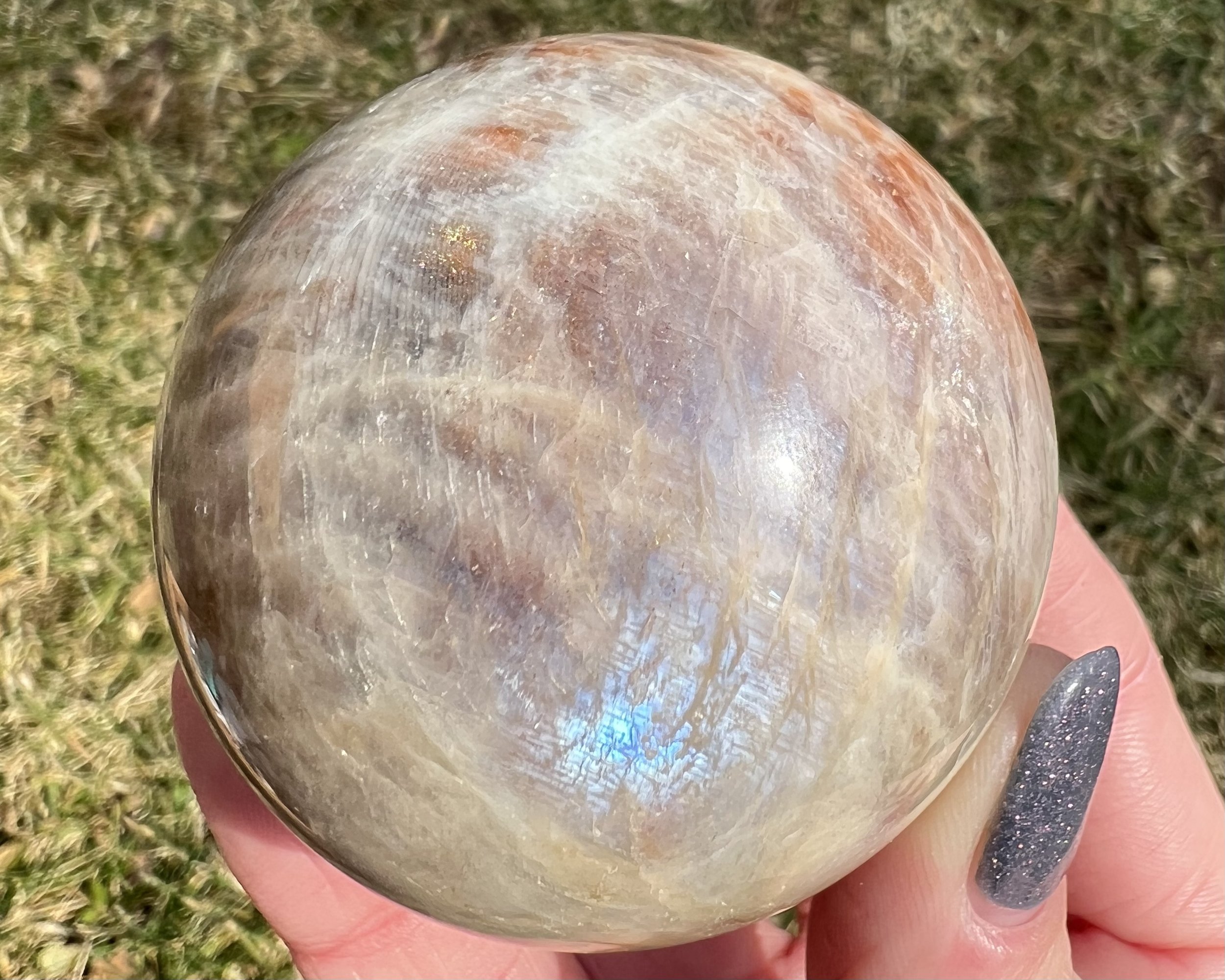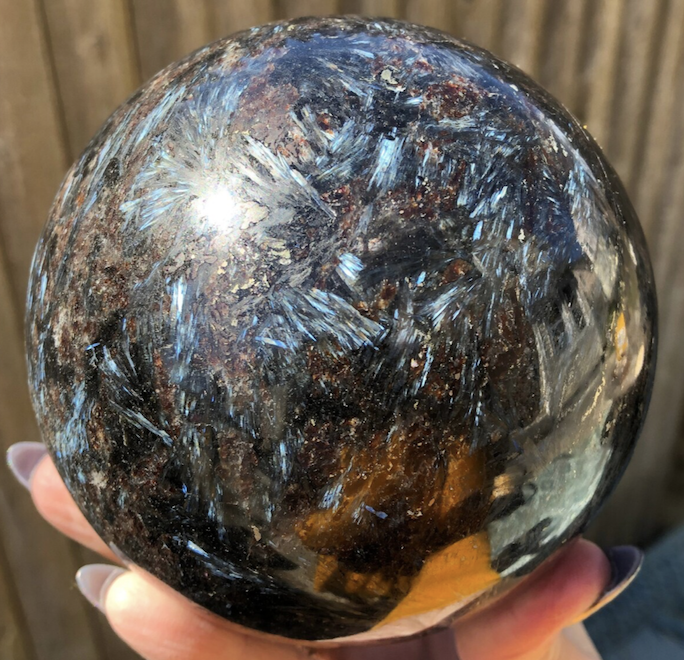
Sunstone and Sunstone and Sunstone
If you look up Sunstone in a google search, you will see many stones that vary wildly in appearance. That is because not all Sunstones are quite the same stone. There are three main types of Sunstones. One is usually mostly orange and more opaque and often has sparkly stuff in it. Another has more sparkles, more rainbows and less orange. The last is more transparent to translucent and may even change colors. They are all feldspars, and have inclusions that cause Aventurescence (also known as schiller) which is "sparkly, metallic-looking luster caused by flat, reflective inclusions" according to GIA. Their mineralogical name is Aventurine Feldspar. Beyond that, these stones have lots of differences.
The Sunstone most commonly seen by the average crystal enthusiast is probably the bright sparkly varieties of the Oligoclase and Orthoclase Feldspar groups. One Oligoclase Feldspar type of Sunstone you've probably seen is from India, cut and polished into spheres and hearts and palm stones. They have bright orange color with shiny Hematite platelets in a variety of colors that give it the trade name "Confetti Sunstone." There are similar varieties of this Sunstone from around the world including Tanzania and Canada.
In Australia, there is a type of Orthoclase Sunstone with long shiny plates of Hematite and Magnetite with rainbow iridescence that can intersect, lovingly called "Rainbow Lattice Sunstone." In these Sunstones the inclusions are hosted in a more translucent or even transparent Orthoclase that shows off the beautiful inclusions in them. In the bottom of this image is another example of an Orthoclase Sunstone- this one from Russia, where the plates are short and hexagonal but also very colorful.
The third type of Sunstone is most famously called Oregon Sunstone. It is the official state gemstone of Oregon. It is technically a type of Labradorite which has Copper inclusions (rather than Hematite ones) that cause its aventurescence. The first recorded occurrence of these stones was by Native Americans who used them in trade and sometimes buried them with their dead. Some Oregon Sunstones have pleochroism, or change colors at different angles. They occur in a range of colors including orange, red, yellow, green and blue.
These Sunstones are the only kind that are faceted often. In the late 1800s Tiffany & Co owned the first commercial mine for Oregon Sunstones which they marketed as "Plush Diamonds" but it didn't catch on as well as they'd hoped and at some point later on they sold the claims. Sunstones are not as popular as other stones in jewelry, but their natural beauty tends to capture the hearts of those who see them up close and in person.
There are mentions of a "sunstone" used by Vikings to navigate the seas in cloudy weather before the invention of the magnetic compass. This "sunstone" however was not Sunstone. We don't know for sure what stone they were using, but a shipwreck from the English Channel that sank in the 1500s had a crystal among its navigation tools, a piece of Optical Calcite- also called Iceland Spar- which is known for its diffraction of light. Many believe that it was pleochroic Iolite, which changes color depending on the angle of light as shown here. Both could be used to determine the position of the sun.
I hope you enjoyed my explanation of Sunstones! You can find several kinds of Sunstones including Rainbow Confetti Sunstones and even Moonstone & Sunstone together, in my Etsy shop. Thanks for reading! -Shawna
Arfvedsonite or Astrophyllite? Neither!
I’ve seen this same stone popping up at trade shows and supplier warehouses for years now, with several different names. Many suppliers call it “Fireworks Stone,” I see lots of it online sold as “Astrophyllite” or “Arfvedsonite.” I’ve seen lots of metaphysical sites comparing the two and proclaiming them to be one or the other. I have spent a long time trying to figure it out and in the past have settled for calling it Arfvedsonite just because I have to call it something. But there are many inconsistencies with those labels when it comes to the stone in question.
First the easiest one - “Fireworks Stone” is not a name of any mineral accepted by any reputable mineral or gem organization. It doesn’t mean anything and doesn’t tell us anything about what it actually is or the minerals in it. We call this a marketing or trade name - someone made it up to sell more rocks because it sounded cool or they didn’t actually know what kind of stone it was- or both.
Next, Astrophyllite. It forms gold, iridescent sprays much like the ones seen in the material in question. However, according to Mindat its color is “bronze-yellow, golden yellow, brown to reddish brown.” The stones that I have seen of the mystery material often have more blue than gold and yellow. Sometimes they are more gold too, but it cannot be Astrophyllite when so much of this material is so very blue. Astrophyllite also occurs more in radial “sun” shapes which often form full circles. Our mystery stone forms more often in “brush” shapes like a paintbrush pressed against a surface.
The third contender is Arfvedsonite. This is what I most commonly see this stone called online. If you post it in a mineral ID group, there will always be someone (never one of the geologists or mineralogists) who jumps to argue that it is Arfvedsonite. Mindat says the color of Arfvedsonite is “bluish-black to black” and in their gallery of 225 photos of Arfvedsonite specimens, all of them look closer to a Black Tourmaline than the material we are trying to identify. Every photo from a reputable source appears much like this photo - very dark or black crystals. Nothing iridescent gold or blue at all.
Finally after many hours spread over several years down this rabbit hole I believe I have found the answer. The name of the mineral in question is Anthophyllite. Anthophyllite is a fibrous amphibole mineral. It is also iridescent but can have gold, yellow, green, blue, and brown - so the iridescence of Anthophyllite fits much better than either of the other minerals it is often called.
On Mindat, there is a photo in the gallery for Anthophyllite that very much resembles the mystery material. It is labeled “Anthophyllite, Garnet, Cordierite.” The piece that I currently have does appear to have a lot of sparkly Almandine Garnet, which makes it a much more believable identification than other minerals. I have often seen the red part of this material called Eudialyte, but none of the aforementioned minerals appear to occur much in association with Eudialyte. My guess is that someone assumed it to be Eudialyte because that is a red mineral associated with Astrophyllite. Anthophyllite, on the other hand has both Garnet and Cordierite listed under common associates.
Another mineral listed under Anthophyllite’s common associates is Gedrite. This is interesting because Gedrite looks pretty similar to Anthophyllite, occurring in fibrous sprays, but is mostly black or dark green. The photo on the left here is Gedrite with Garnet. In the material I have now, shown on the right, there is a lot of shiny black sprays that are around the golden ones, and Anthophyllite and Gedrite do indeed occur together. Random fun fact- Gedrite and Anthophyllite alone together have a trade name you’ve probably heard before - Nuummite!
I found an article on Epigem that talks about this stone pictured, found in Sweden and described as an Anthophyllite schist “with reddish brown garnet, granular epidote and colorless cordierite.” This makes so much sense because so many of the pieces of this material I’ve had also had bits of green in them, and the one I’m looking at now does have some areas of clear stone that appears to sparkle similar to other cordierites I have had. In comparison, Cordierite does not often occur with Arfvedsonite, which mostly forms on Feldspars. It is also not listed as an associated mineral of Astrophyllite. So again, it seems that Anthophyllite is the most likely identification of these no-longer mysterious iridescent blue and gold sprays.
New Moon Ritual: Setting Intentions
The New Moon occurs when the Sun and the Moon are on opposite sides of the Earth, and none of the light from the Sun is reflecting off of the Moon. The New Moon is a moment of darkness, a prime time for reflection, release and setting new intentions.
There are many rituals out there for New Moons, many of them long, elaborate and requiring a lot of tools or ingredients. Maybe you don’t have the time or the energy for all that. Maybe you don’t consider yourself a ‘witch,’ per se, or maybe you don’t have a large dedicated sacred space. Maybe you don’t have time to spend an hour in a fancy herbal salt bath surrounded by black candles. I’ve come up with a pretty easy, simple New Moon ritual that anyone can do with a few simple things that most of you will already have in the house. It doesn’t take up your whole night, and its still powerful af.
Step 1: Grab your journal or some paper and a pen, and write down everything you need to get out. Write about things you’ve had on your mind, things that have been bothering you, and just vent. Release all your worries and grievances into the paper, without thinking too much and without judgement. Just write it down and feel the tension and negativity leaving your body.
Then, write at least two things you are grateful for. They could be things that happened today, things that made you laugh, or things that you are grateful for everyday like your kids or your car. They can be as small or big as you want.
Finish off by writing about the future. What are things that you want to happen in the next four weeks or beyond? Just let your mind wander and write down wherever it goes. Don’t take more than five minutes for this part, as it can spiral out of control pretty easily.
Step 2: Cleanse your space. Whether you’re at an altar, sitting on your bed, or hiding in the bathroom, you’ll want to cleanse your self, your space and your tools. You can use sage, Palo Santo, juniper, rosemary, and other plants to cleanse with smoke. If you can’t use smoke, there are smudging sprays available too. (This one is my fave.) You can also cleanse with sound, using a singing bowl, gong or bell.
Step 3: Light a candle. It can be any candle you’ve already got, or a special one that you only use for New Moons, or even a fancy specific ritual candle made just for you. It is up to you to choose the type of candle you want to use. Smaller ones tend to be better because you’ll want to let it burn out on its own.
Optional: Charge your candle! After it has been cleansed, hold the candle, feel gratitude and love, visualize what you want, and ask for it from the Universe. Light the candle and place on a heat-safe surface.
Step 4: Crystals. You should gather the crystals you’d like to use before you begin the ritual so that they are part of your cleansing. You might also cleanse all of your crystals as part of your ritual, and then choose them when you are ready. When it comes to choosing which crystals you will use, you can pick whichever ones you feel most drawn to, or ones that are most related to your intentions, or use these New Moon faves: (click on any name to shop that type of stone)
Moonstone: For tapping into lunar energies, new beginnings, inner strength, intuition
Labradorite: For transformation, strength, easing change, hidden magic, reinvention, self love
Clear Quartz: For magnifying, energy cleansing, balance, manifestation
Black Tourmaline: For grounding, protection, blocking and removing negative energy
Indigo Gabbro: For connecting to New Moon energy, clairvoyance, seeing your inner darkness, balance between light and dark
Step 5: Setting intentions. Write down your intentions on a fresh piece of paper that you will keep and refer to for the next four weeks. Write your intentions as if they are already happening now. Write them with gratitude. Avoid negatives- what you focus on becomes your reality. (For example, if you want to become free from debt, focus on wealth and financial freedom - not the debt!)
After you write each intention, visualize it as if it is already true- and most importantly- FEEL those feelings that this reality gives you. If you’re manifesting money, imagine the money is in your hands- see it, feel it, visualize yourself spending it - giving it purpose - and FEEL the feelings of gratitude, of having financial independence, and whatever feelings that makes you feel. To HAVE that now. Go through this for each intention. Feeling them as if they are already here is the most important part.
Step 6: (Optional) Meditate, do a tarot reading, or both. You could do a simple five minute meditation to clear your mind and listen for your intuition. You could do a simple three card spread. One example could be 1. Where you are now 2. What to release 3. What action to take.
Step 7: Make a list of 3-5 steps you can take this moon cycle toward making your intentions a reality. They should be actionable steps, they can be as small as researching or scheduling an appointment or as big as hiring a coach or applying for that position you want. But they need to be specific actions that you can take. At least one should be something you can do in the next few days.
Step 8: (post ritual) Put your intentions somewhere you can see them every day. As often as you can find a few spare minutes, read each one aloud, using visualization and feeling those feelings, to make them true. Cross off your steps as you complete them, and add another step for each completed one. This will keep you from losing sight of your goals.
Crystals through Time
Crystals and precious stones are often used by people to heal trauma, treat ailments of mind and body, and protect them against negative energy. It seems to have been true for many years, even if it just became more popular recently. But who started this practice?
The first recorded use of crystals was by the ancient Sumerians, one of the first civilizations, who used crystals in their magical healing formulas and for inlays in their finest artwork. Lapis Lazuli and Serpentine were a couple of their favorites.
Egypt too is an ancient civilization with a rich history of using crystals for many purposes. Egyptians used them mainly for protection and good health, often in the form of jewelry. Quartz, Emerald, Lapis Lazuli, Carnelian, and Turquoise were some of the most popular stones. Egyptians of all classes, both male and female wore lots of jewelry. Amulets were often made to protect the wearer, in life and especially in death. Jewelry was usually made with a specific purpose such as protection of health, warding off evil spirits, and bringing good luck. Those who made the jewelry had to follow strict rules regarding the magical properties of certain colors, shapes and materials.
Egyptians prized Lapis Lazuli more than gold. It was used in making heart scarabs, which were placed on the heart of the deceased in burial to protect the heart in death. It was also crushed and used as make-up, along with Malachite. Galena was ground up into the famous eyeshadow called kohl. Garnet was used to promote good health and for protection. Malachite was used to line the headdresses of pharaohs to help them rule wisely and promote inner visions. Carnelian was worn to purify the blood and relieve pain.
Ancient Greeks were the ones who coined the actual word ‘crystal,’ from (krustallos) meaning “ice” or “rock crystal” because they believed that Quartz crystals were water that had become eternally frozen. They used Amethyst amulets to prevent drunkenness and hangovers and the word Amethyst means ‘not drunken.’ Hematite is associated with the Greek god of war, Aries, and soldiers would rub it all over themselves before battles to make themselves invulnerable. Sapphires, whose name comes from the Greek word ‘sapphirus’ meaning blue, were a favorite among the kings and priests of ancient Greece due to their association with purity and wisdom.
In ancient China, Jade was valued so highly by the culture that they had their own written characters in the language. Some emperors were buried in jade armor, and even with jade horses. Jade symbolized moral integrity and purity. It was believed to have kidney-healing powers as well. Jade was carved into all types of objects, including jewelry, ornaments, ritual tools and even chimes. Jade was even used to seal the orifices of bodies for burial! Men were seen as virtuous for having Jade ornaments on their desk and in their homes.
The Native Americans have always had a deep respect for crystals and their use in healing. Much of their history is lost now because traditions were passed on orally from generation to generation, and many of the languages have been lost over time as the native populations have been decimated by genocide. The Native Americans saw the crystals as powerful tools given by the Earth, which were to be used carefully, respectfully and only by those who knew how to use them properly. Turquoise was known as the stone of the sky - created by rainwater mixed with tears of joy that has sunk into the Earth. Many tribes used Turquoise in all types of ceremonies and rituals, to bring rain, for protection, and even as a currency.
What we now call birthstones originated from the Book of Exodus. The Breastplate of Aaron was a sacred object worn by the High Priest of the Israelites in order to communicate with God. This breastplate had in it twelve different stones, “one for each of the names of the sons of Israel,” and they were arranged in a square worn across the chest. When the first academic research was carried out by a roman scholar, a list of the stones was compiled from his findings - the first list of “birthstones” was created. Before the 17th century, people wore the stone of each month during that month, rather than wearing their personal birthstone all year.
Crystals and stones play many more roles throughout different religions. One issue with these ancient stones is that there was no accurate way to classify stones before the 1500s. Stones were named according to color a lot of the time and there is no sure way to know what many stones’ names meant when they come up in ancient texts. For example “Carbuncle” is the name for all red gems in the Bible, but could also refer to Coal. In the Koran, the 4th Heaven is made of ‘Carbuncle.’ The Hindu Vedas, the oldest and most sacred of Hindu texts, describe the powers and healing properties specific to different crystals and gemstones.
The earliest known use of crystals dates back 30,000 years to the first amulets made of Baltic Amber - though there are no records to tell us how they were used at that time. Today crystals have become popular again as healing and spiritual tools but they also run our computers, keep our time, power our electronics and so much more. Crystals are part of your heritage, your everyday life, and they will bring us into the future too.
Suspicious Citrines
Citrine has many forms, but not all of the stones called by this name are truly Citrine. Amethyst in disguise is only the tip of the iceberg!
First of all, let's start with what Citrine IS. Citrine is a variety of Quartz, Silicon Dioxide, that has yellow, yellowish green, or yellowish brown coloring. Citrine is found in locations all over the world but is considered rare in its natural form, as seen here.
The most common way that false Citrine is created, is to heat Amethyst at high temperatures until it turns orange. All bright and dark orange Citrine is in fact heated Amethyst. Below is an Amethyst geode that has been cut in half, with the right side heated to produce orange Citrine. The orange can range from bright to dark, brownish orange but always orange. True Citrine is never this color, although sometimes Amethyst is heated to orange naturally.
Genuine Citrine will always have yellow based coloring. It can be pale yellow, yellowish brown, yellowish green, bright yellow, or even yellowish orange like this Citrine:
It can sometimes be so similar to light Smoky Quartz that it is impossible to discern between the two, in which case either name is correct. This rare Smoky Citrine here is from the Congo and often called Kundalini Quartz. This coloring can also be referred to as "honey" Citrine.
This one has dark, smoky phantoms in yellow Citrine, cut and polished into a point:
These are also natural Citrines that have been cut and polished into points. These ones are from Brazil:
There are other instances where crystals are mistakenly called Citrine due to their color, even though they are completely natural.
One example is when clear Quartz is coated in iron oxides that are yellow or orange in color. These naturally occurring coatings can be opaque or translucent, but some people mistake the overall orange or yellow coloring for being Citrine.
Spirit Quartz is another crystal that I see being called Citrine quite a bit. These crystals feature a Quartz or Amethyst crystal that has a second generation of smaller Quartz or Amethyst crystals formed along the sides.
They occur as Amethyst, or white Quartz, but never actual Citrine, or Ametrine, though both often have some orange or gold colored iron oxidation.
True Ametrine, the bicolor mix of Amethyst and Citrine, is very rare and only legitimately mined in Bolivia at the Anani Mine site. It is also called Bolivianite. Sometimes Amethyst has orange iron oxides in it and will appear similar to Ametrine, but you need to be very careful about location and identification.
This is a genuine, bicolored Ametrine from Bolivia that has been faceted for jewelry.
So keep in mind that there is much more to Citrine than just the color of the stone! And maybe keep a real one in your pocket or on your desk if you're looking to make better money ;)



















































